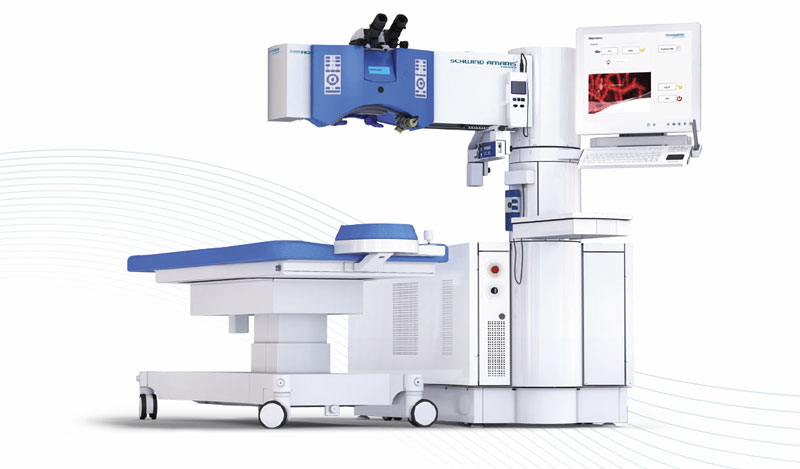
When we speak of "laser refractive procedures", we mean the use of a laser to correct the common refractive disorders: myopia (nearsightedness), hyperopia (farsightedness), and astigmatism. Many of the terms used in this discussion will depend on an understanding of the eye.
The basis for nearly all kinds of laser refractive procedures is the reshaping of the cornea. Myopia is corrected by making the cornea flatter, hyperopia is corrected by making the cornea more curved, and astigmatism is corrected by making the cornea more perfectly round (i.e. less oblong).
The excimer laser produces a beam of ultraviolet light, which means that its wavelength is somewhat shorter than that of visible light. More specifically, the wavelength of the ArF laser is 193 nm (19.30 millionths of a centimetre or about 7.6 millionths of an inch). This wavelength is uniquely suited to the task of corneal procedures. When this light meets corneal tissue, molecular bonds are broken and a microscopic layer of tissue is removed with no thermal (heat) damage to the remaining tissue. This allows the cornea to be sculpted gently and precisely.
Photorefractive keratectomy (PRK) is the procedure in which the front surface of the cornea is directly sculpted into a more desirable shape by an excimer laser after the doctor removes the outer "skin" (the epithelium). In the early 90's, the epithelium was removed by scraping or by applying topical alcohol. This older technique resulted in slower healing and more discomfort after the procedure. The slower healing and discomfort issues of PRK are eliminated with the latest technology in laser refractive procedures, the SmartSurfACE Laser Procedure(SLP).
In conjunction with Schwind Eye Tech Solutions, our doctors have developed Smart Pulse Technology, which evolved to the SmartSurfACE Laser Procedure. SmartSurfACE is a completely touch-less procedure – no scraping, no cuts, no incisions, and no alcohol. The SmartSurfACE laser operates at 1000Hz (vs the traditional 400 Hz). The laser utilizes a 7-directional ocular movement tracking system which results in perfectly centered treatments even if the patient has difficulty holding still during the procedure. Treatment time is efficient at approximately 40 seconds per eye, and slightly longer for higher prescriptions. This one-step trans- epithelial procedure offers higher safety compared to LASIK, with no flap or intra-stromal complications, and no risk of ectasia (excessive weakening of the cornea). This is also associated with faster visual recovery compared to traditional PRK.
SmartSurfACE is suitable for patients with thin corneas or complex corneal topographies, such as keratoconus. The advanced laser allows our doctors to treat almost all levels of myopia in the safest manner possible
Laser-assisted intrastromal keratoplasty (LASIK) is a procedure in which a flap is created with a specialized blade called a keratome, or a femtolaser. This flap, attached to the cornea by a hinge, is lifted away from the rest of the cornea. The underlying corneal bed is then sculpted by an excimer laser, and then the flap is put back in its original position.
In the past, the advantage of LASIK was quicker visual recovery compared to traditional PRK. With the advancement of technology and techniques, the benefit of quick visual recovery with SmartSurfACE, especially immediately after procedure, is almost equivalent to that with LASIK.
Studies have shown that the LASIK flap does not heal completely. There have been incidences when blunt trauma can dislodge the flap even over 10 years after a LASIK procedure. As there is no flap in SmartSurfACE, this is not an associated issue. Long term follow-up has shown that LASIK can be associated with corneal weakening, known as ectasia. This is a rare condition where the cornea weakens uncontrollably and can be only treated with corneal cross-linking or a corneal transplant. This condition is not associated with PRK or SmartSurfACE.
Keratoconus is a disease of the cornea in which a normally round, dome-shaped cornea progressively thins, causing a cone-shaped bulge to develop. Keratoconic corneas have too few or weaker than normal collagen bonds, and the weakened configuration leads to bulging, steepening, and irregularity. The normal eye pressure pushing out on the thinned areas of the cornea causes the cone-shaped protrusion. The irregular shape of the cornea can cause decrease visual acuity, which may not be correctable with corrective lenses in severe keratoconus.
Until now, a corneal transplant was the only treatment option available for advanced keratoconus.
Corneal Collagen Cross-linking is a new, minimally-invasive surface treatment for keratoconus, performed using a topical anesthetic. During treatment, the outer layer of the cornea (the epithelium) is removed. A photosensitizing solution consisting of riboflavin (vitamin B2) is applied to the cornea and is exposed to a low dose of ultraviolet light. The photosensitizer reacts with the ultraviolet light to create new collagen bonds (cross-links) throughout the cornea. Once the procedure is complete, a bandage contact lens is placed over the cornea to help the epithelium grow back (usually within 5-7 days) and to facilitate recovery.
By creating new collagen bonds, cross-linking strengthens and adds resilience to corneas affected by keratoconus. If performed early enough, cross-linking may delay or prevent the corneal weakening from keratoconus and allow good vision to be preserved. In advanced cases, cross-linking may delay the need for invasive corneal transplants and prevent vision from worsening
At Pacific Laser Eye Centre, we are able to combine the corneal cross-linking procedure with CUSTOM-TNT, a topography-guided treatment. Refractive error associated with the keratoconus can be improved and the underlying cause of keratoconus is treated.
We have developed CUSTOM-TNT which is our innovative method for creating a customized smoother corneal surface, based on each individual patient.